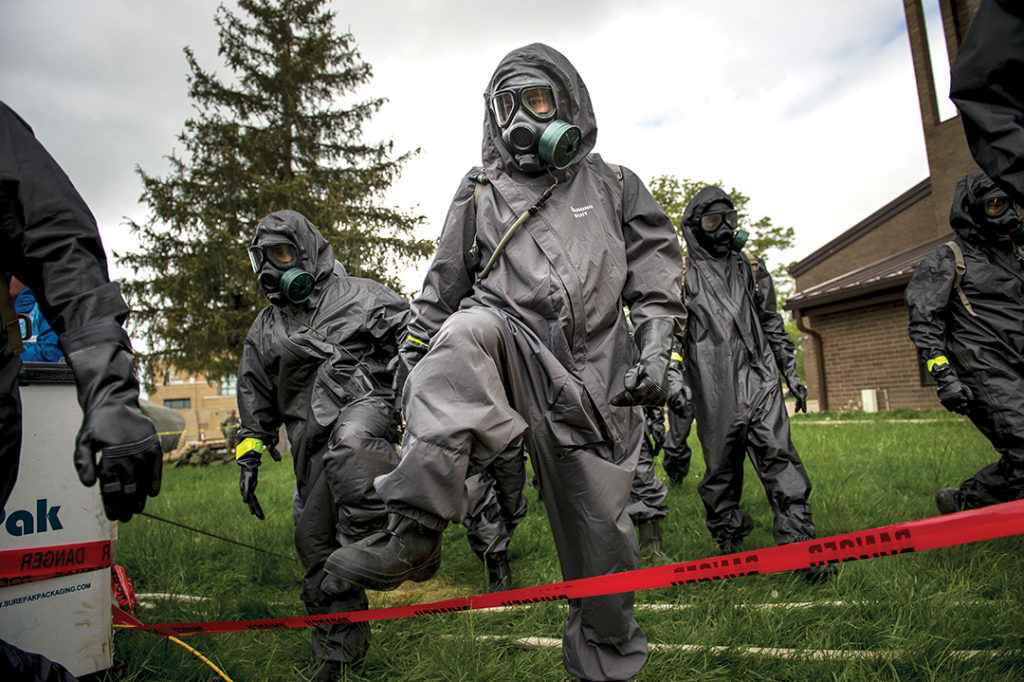CBRN Response Force is always ready
THE WATCH Staff
It’s a nightmare scenario: A 10-kiloton nuclear device is detonated at the entrance to New York City’s Lincoln Tunnel. It could kill thousands, cause widespread panic and cut off much of the city from outside help.
The attack is almost unimaginable, but the job of the Defense CBRN Response Force (DCRF) is to imagine it and figure out how to save the most people and minimize the damage. Created in 1999, the DCRF is a national joint task force designed to respond to a catastrophic attack involving chemical, biological, radioactive or nuclear (CBRN) agents.
It has never been activated, but it undergoes training designed to mimic reality so that its members are prepared for the worst.
U.S. Army Maj. Gen. Richard J. Gallant, commander of the DCRF, calls it the nation’s “insurance policy” against a major attack. “All of us hope nothing like this would ever happen, but we can’t be caught unprepared if it did,” Gallant told Federal News Radio. “We also have other capabilities. Because we’re constantly training, we’re also capable of responding to an all-hazards event.”
Made up of 5,200 Soldiers, Sailors, Airmen and civilians from active-duty and reserve units, the DCRF is ready to deploy within 24 hours of being notified. The force includes people who specialize in chemical detection, search and rescue, decontamination, evacuation and much more. Its tasks fall into four general categories: aviation, logistics, medical and operations.
The scenario described was tested in Guardian Response 17, an exercise that simulated what a whole-of-nation response to a nuclear attack might look like.
For the exercise, nearly 4,100 Soldiers gathered at the Muscatatuck Urban Training Center in Indiana, which was made to appear as if it had suffered a bomb blast, complete with debris, smoke, downed trees and actors playing victims. Responders were asked to search for victims in the rubble, transport the wounded, and coordinate actions with local, state and federal officials. Most of the activity was done wearing cumbersome hazmat suits to prevent radiation exposure.
“We’ll be treating between 60 and 80 casualties per hour,” said U.S. Army Reserve 1st Lt. Erin Lovinus, a medical liaison officer with the 409th Area Support Medical Company. “We’ll carry this mission on anywhere from 12 to 15 hours per iteration. This exercise is as realistic as it can be.”
If a disaster hits the U.S. homeland, the DCRF will play a support role with local authorities in charge. Since all entities have different procedures, learning how to work together during an exercise like Guardian Response is key.
“It’s much better to practice and improve response coordination,” said Lt. Col. John Pitt, Muscatatuck Urban Training Center commander. “Practice that saves lives, eases suffering and provides assistance that helps return citizens’ lives to normalcy.”
Each exercise tests the limits of DCRF capabilities and shows where the force must improve. For instance, Soldiers working in the “hot zone” must be rotated out every 90 minutes and spend time in the decontamination center. This constant rotation of personnel requires precise coordination achieved through repetition.
“We have to provide the right force with the right response and the right experience. If we use, God forbid, the worst possible scenario, then it helps us get after all those slower-developing scenarios that we respond to,” Gallant said. “We are in support of the first responders, and we provide the capability that can augment their operations.”

